Book choices for today:
Flower Garden Eve Bunting
Flowers (Plant Parts) Vijaya Bodach
Flowers Gail Gibbons
The Grouchy Ladybug Eric Carle
Beetle Bop Denise Fleming
Creepy Beetles Fay Robinson
The Very Clumsy Click Beetle Eric Carle
Are You a Ladybug? Judy Allen
A Ladybugs Life John Himmelman
Botany: (first circle)
Need for lesson – Real or fake flower that clearly shows the parts of a flower, Montessori Flower Puzzle, and Parts of a Flower Booklet.
Botany 26
In the Botany area of our classroom we have learned many thing about plants. Let’s think about the parts of a plant, can you tell me some of them? We have talked about things like the different parts of a leaf or root. Now we want to find out about the flower part of a plant, and the parts of a flower.
Most kinds of plants have flowers. Any plant that has a flower is called a flowering plant. Many trees have flowers, so they are considered flowering plants as well. Flowering plants grow all over the earth. Flowers are where the seeds are made. These seeds will grow into new plants. Most plants flower during the seasons of Spring and Summer.
The first thing we see when we look at a flower are its petals. Together, all of the petals of a flower are called a corolla. Oil in the petals give the flower its sweet smell. The flower has male parts and female parts. One of the male parts are called the stamens (using the fake or real flower, show the children as each is discussed). This is one of the female parts called the pistil. Sitting on top of the pistil is the stigma. The stigma is the part that we see in the center of the flower. It is a sticky bulb that receives pollen grains which they germinate. We are going to talk about germination on a different day. This part of the flower is called the calyx. The calyx protects the flower before it opens and, after the flower’s blossoming, can be seen at its base. Many flowers contain a sweet liquid called nectar. This is stored at the base of the petals in the nectary.
We can make a flower booklet that names some parts of a flower.
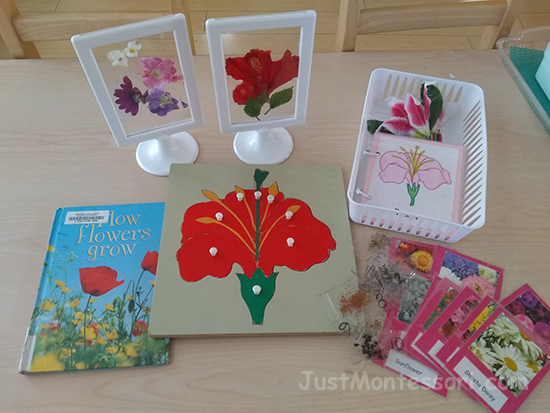
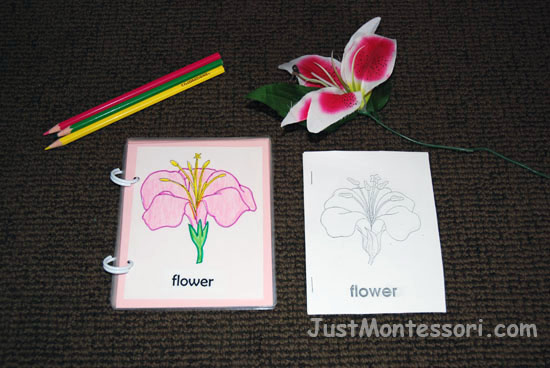
Parts of a Flower Booklet (Montessori Catalogs)
Additional Works:
Felt Parts of a Flower – I made this out of felt and made labels to match.
Flower Water Coloring – Children can trace the flower puzzle and use water colors to paint them.
Flower Matching Cards – These cards are from Kidssoup.com, but can also be made with pictures from a flower magazines or stickers.
Flower Stamping 1-10
Flower Frames – These are great frames! Take a flower and break it up into parts to display.
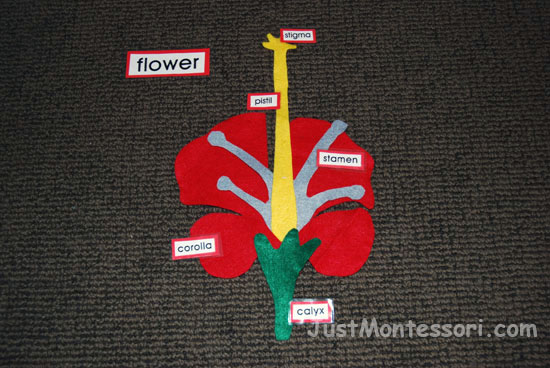
Felt Flower
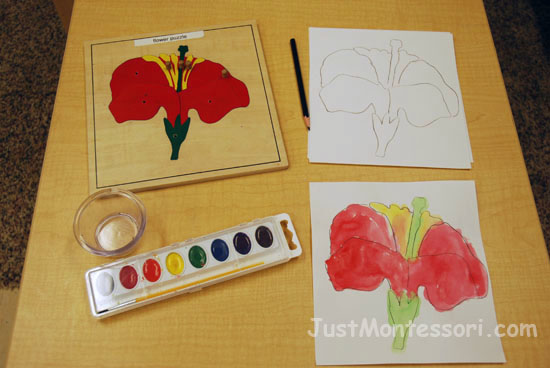
Flower Water Color
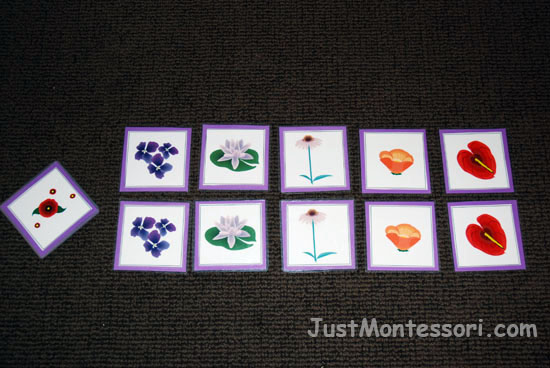
Flower Matching
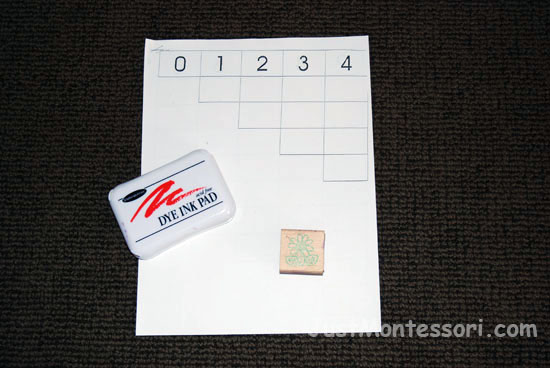
Flower Stamping 1-10
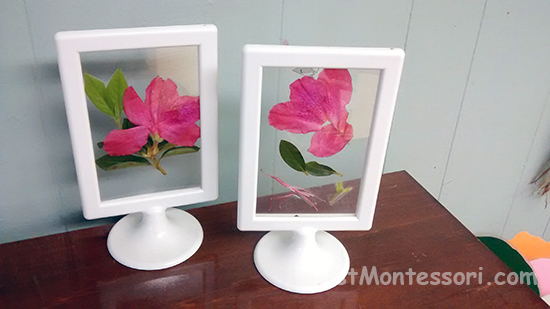
Flower Frames
Book Idea:
After reading the book, Flowers, children can plant flower seeds.

Flower Planting
Songs/Poems:
My Garden (can be acted out)
This is my garden, I’ll rake it with care
And then some flower seeds I’ll plant in there.
The sun will shine, and the rain will fall
And my garden will blossom
And grow straight and tall.
Little Flower
If I were a little seed planted in the ground,
I’d stretch my roots and grow and grow;
I’d stretch my stem and grow and grow;
I’d blossom into a pretty flower
Then I’d sway back and forth as if to say,
“I’m glad to be with you today!”
Zoology: (second circle)
Need for lesson – Pictures of different beetles, especially ladybugs and Parts of a Ladybug and real ladybugs or other beetles.
Zoology 35
Insects are a kind of invertebrate. How do we know if it is an insect? Beetles are a kind of insect. There are many different kinds of beetles. One kind of beetle is a ladybird beetle, or ladybug. There are about 5,00 different species of ladybugs in the world! They come in many different colors and patterns, but we are most familiar with those having a red and black body. Most people like ladybugs because they are pretty, graceful, and harmless to people. They like to eat other insects, mostly aphids. Farmers and gardeners like having ladybugs around because they eat aphids. Aphids like to eat plants in a garden. Ladybugs help to keep aphids from eating a farmers crops or one’s garden vegetables. Ladybugs are colorful for a reason. Their bright colors tell other animals that they taste awful, and so animals like birds and frogs will stay away from ladybugs.
Ladybugs lay eggs. We learned that insects have to go through metamorphosis. When ladybug eggs hatch, they are called larvae. The larvae grow quickly and shed their skin several times. When they reach full size, they attach to a leaf by their tail, and a pupa is formed. Within a week or two this pupa becomes an adult ladybug. Looking at the adult ladybugs wings, what do you notice about them? They have symmetry. What is symmetry?
Ladybugs live in different habitats. They can be found in grasslands, forests, and even in cities. ladybugs are active and can be seen from the spring until fall. When the weather turns cold, they look for a warm place to hibernate. They may hibernate inside logs, under rocks, or in a house. A colony of hibernating ladybugs can contain thousands of them. What would you think of finding thousands of hibernating ladybugs?

Beetles
(from: Life of the Ladybug and Beetles by Ann Squire, and Beetles by Peter Murray)
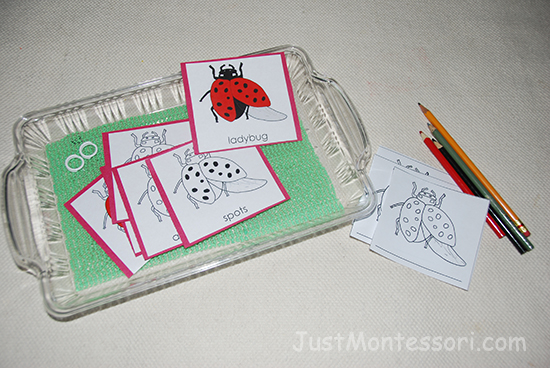
Parts of a Ladybug (MontessoriPrintShop.com)
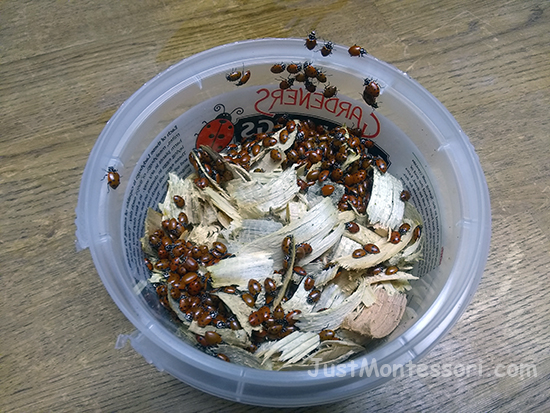
Ladybugs
Additional Works:
Beetle Matching Cards – I made these using stickers.
Ladybugs Erasers – Can be used for simple subtraction.
Ladybugs – I put these on the Practical Life shelf with a piece of felt.The children roll out the felt and they can line up the ladybugs or arrange them on the felt into different shapes or designs.
Ladybug Spots – These are picture cards of ladybugs with spots 1-10. Children place cards across mat and add beans or other object to each spot on the cards.
Ladybug Clothespins – Children clip the mini pins to the dots along the stick.

Beetle Matching
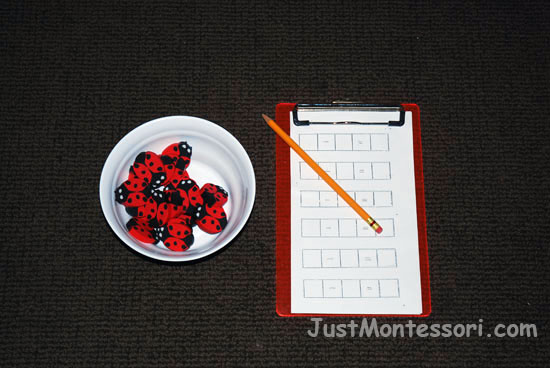
Simple Subtraction
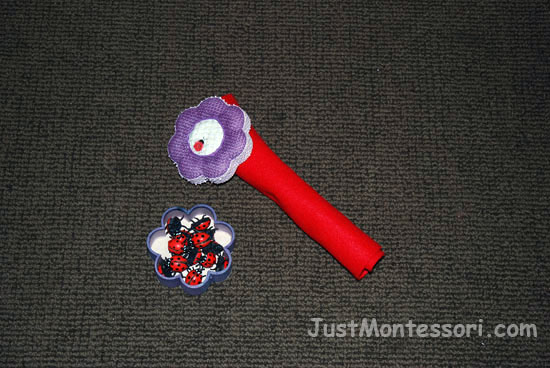
Ladybugs
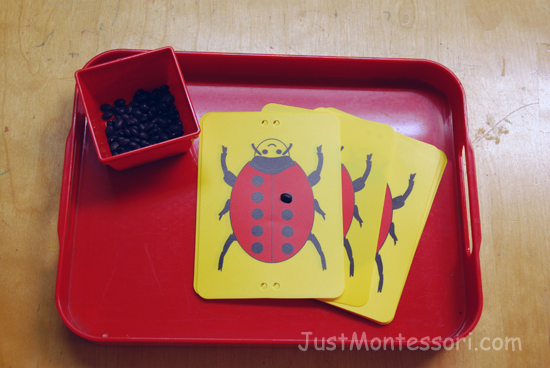
Ladybug Spots 1-10
Art:
Ladybugs
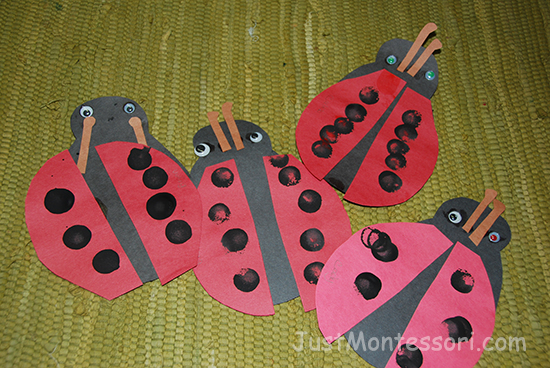
Art
Practical Life:
Clothespins– I painted a craft stick and placed dots along it. Children clip pins over the dots.
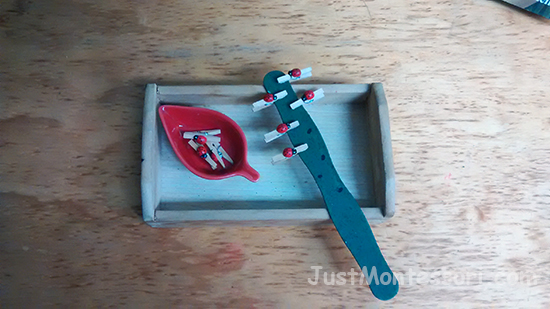
Ladybug Clothespins
Songs/Poems:
Five Little Ladybugs (from kinderkorner)
Five little ladybugs, climbing on some plants,
Eating the aphids, but not the ants!
The first one said: “Save some aphids for me!”
The second one said: “These are tasty as can be!”
The third one said: “Oh, they’re almost gone!”
The fourth one said: “Then it’s time to move on!”
The fifth one said: “Come on, lets fly!”
So they opened their wings and flew through the sky.
Once There was a Ladybug (tune – Mary Had a Little Lamb)
Once there was a ladybug, ladybug, ladybug
Once there was a ladybug, who went outside to play.
She liked to crawl around, crawl around, crawl around
She liked to crawl around, crawling different ways.
Once a great big bird came by, bird came by, bird came by
Once a great big bird came by, and so she flew away!
Little Red Bug (from kinderkorner, changed slightly) Can be made into a work for the poem basket or tray.
Little red bug, oh so cute,
Here’s a black spot for your suit.
Now you go and have some fun
With your spot, your very first one.
Little red bug, oh so cute,
Here’s a black spot for your suit.
It’s so nice to own a few,
So enjoy these lovely two.
Little red bug, oh so cute,
Here’s a black spot for your suit.
We are very pleased to see
How nice you look with all three.
Little red bug, oh so cute,
Here’s a black spot for your suit.
You might feel you need more,
So we proudly give you four.
Little red bug, oh so cute,
Here’s a black spot for your suit.
Goodness, goodness, sakes alive,
Look at you, you’re wearing five!
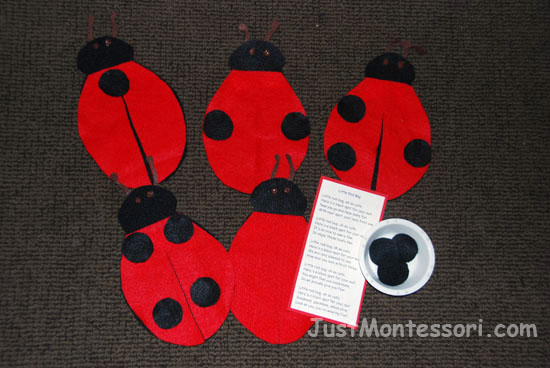
Little Red Bug – Poem Basket
Song (CD) choices for today:
Ladybug Time for Music
Flower to Flower Time for Music
Parts of a Flower Dr Jean
-
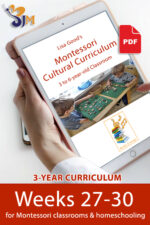 (H) Weeks 27-30$25.00
(H) Weeks 27-30$25.00


